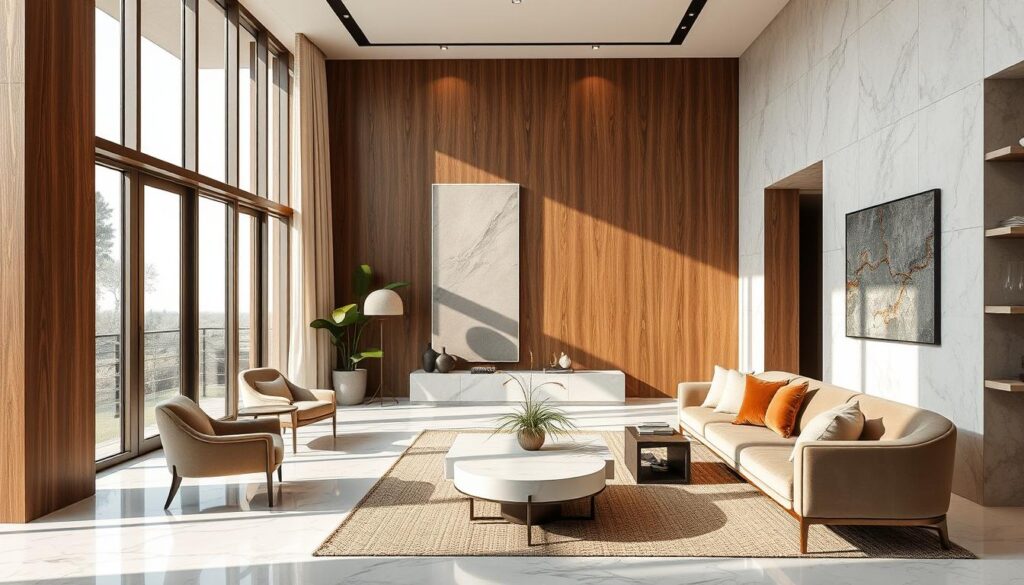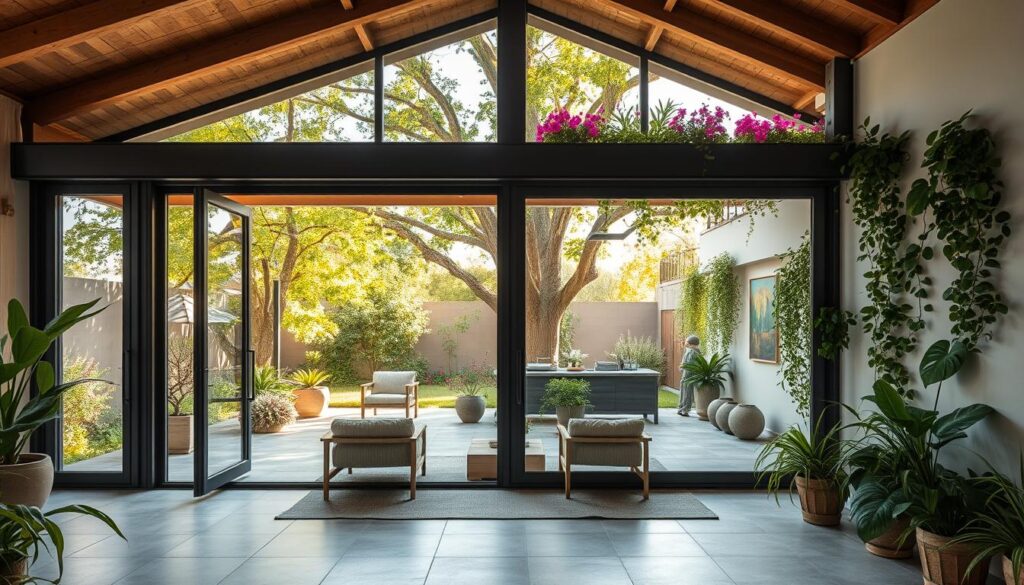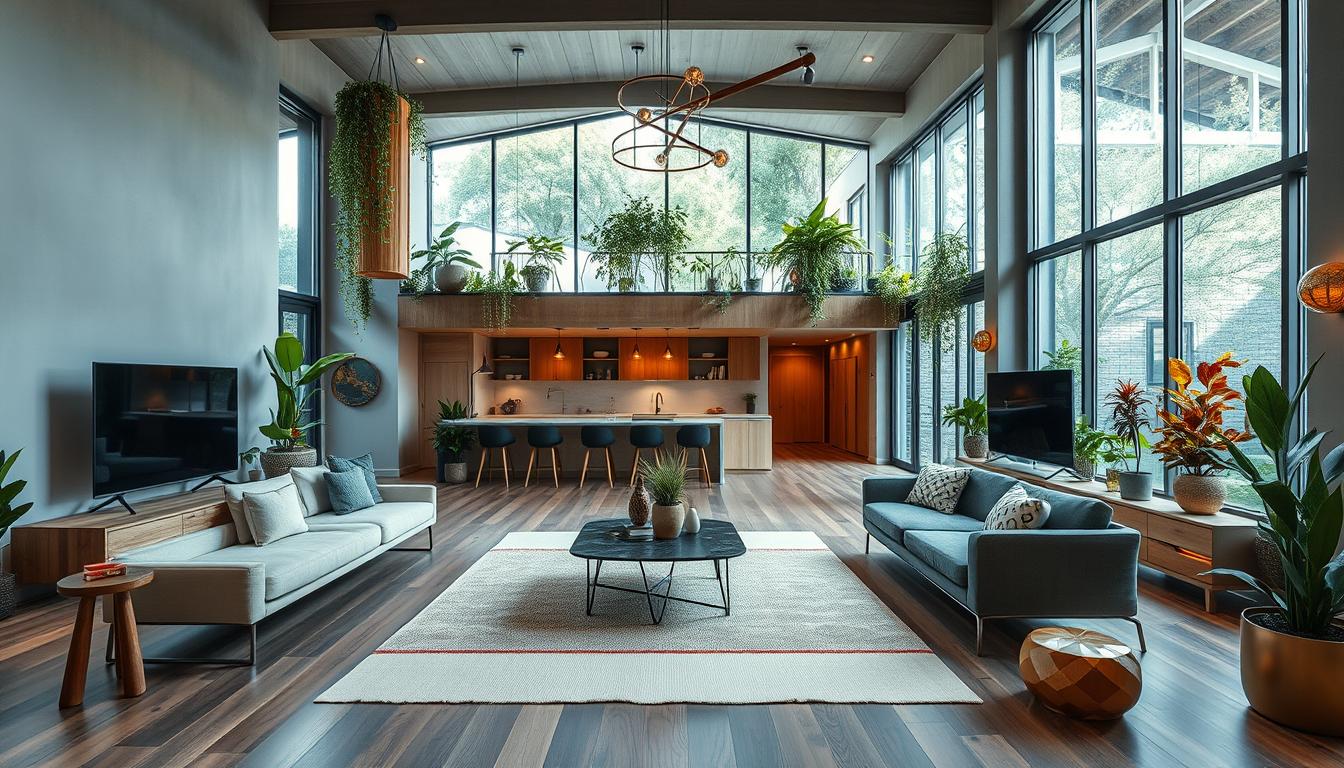The interior design industry is poised to reach a monumental valuation of $255 billion by 2025, underscoring the escalating importance of interior architecture. This burgeoning sector necessitates a vigilant pursuit of current trends and practical tips for 2023. This year, aficionados and professionals alike are gravitating towards cutting-edge concepts. These innovations aim to elevate aesthetics while concurrently boosting functionality and environmental stewardship in both domestic and commercial settings.
By grasping the latest interior architecture trends, you can curate spaces that mirror your personal style while optimizing comfort and efficiency. This exploration will encompass crucial insights into sustainable practices and the integration of smart home technologies. Such knowledge will empower you to revolutionize your living environment with precision and flair.
Key Takeaways
- Stay informed about evolving trends to enhance your design projects.
- Embrace sustainable materials and practices for a greener future.
- Consider the psychology of color to influence mood and ambiance.
- Integrate smart technology for increased comfort and convenience.
- Create multifunctional spaces to optimize usage and flexibility.
- Explore the charm of vintage designs while blending modern aesthetics.
- Utilize layered lighting techniques to enhance the overall atmosphere.
Introduction to Interior Architecture Trends in 2023
Interior architecture is instrumental in crafting environments that are both functional and aesthetically pleasing. It ensures that every square foot is utilized effectively, whether in residential or commercial settings. This discipline’s significance becomes apparent when one considers its impact on both the visual appeal and practicality of our daily lives.
The Importance of Interior Architecture
The essence of superior interior architecture resides in its capacity to forge spaces that are in perfect harmony. It optimizes the use of light, color, and materials, thereby enhancing the inhabitant’s experience. This principle is applicable across all settings, from intimate homes to dynamic offices. Designs that seamlessly merge comfort with style exemplify the pinnacle of residential and commercial space optimization.
How Trends Evolve Over Time
The trajectory of interior architecture trends is shaped by cultural evolution and technological progress. Designs that blend historical inspirations with contemporary elements emerge, offering spaces that exude timeless elegance. Designers must be agile, drawing from the past while integrating modern elements to meet shifting consumer preferences. This continuous evolution ensures that designs remain relevant and impactful in the dynamic world of interior architecture.
Sustainable Design in Interior Architecture
The ascendancy of sustainable design within the domain of interior architecture is a phenomenon of recent vintage. This paradigm seeks to diminish environmental footprint whilst augmenting the aesthetic and functional attributes of spatial configurations. Through the employment of eco-friendly materials and the adoption of energy-efficient methodologies, designers are able to craft interiors that not only bolster a healthier planet but also enhance the quality of life for inhabitants.
Eco-Friendly Materials to Consider
The selection of materials is a critical determinant in sustainable design. A plethora of eco-friendly materials emerge as exemplary for their minimal environmental impact:
- Bamboo: Renowned for its accelerated growth rate, bamboo is both sustainable and remarkably versatile.
- Reclaimed wood: Utilizing reclaimed lumber diminishes waste and imparts distinctive character to interior spaces.
- Recycled metals: Metals that have undergone recycling necessitate less energy for processing, thereby reducing their carbon footprint.
For a more detailed exploration of sustainable materials, refer to this resource, which offers insights into the array of eco-friendly options currently available in the market.
Energy-Efficient Practices
The integration of energy-efficient practices within interior environments can yield substantial savings and diminish energy consumption. Effective strategies include:
- Adoption of smart lighting systems that dynamically adjust based on occupancy and ambient light levels.
- Selection of energy-efficient HVAC systems to optimize heating and cooling without excessive energy expenditure.
- Employment of high-performance insulation to maintain thermal comfort and enhance energy efficiency.
These energy-efficient strategies not only curtail utility expenses but also contribute to a more sustainable living environment.
Benefits of Green Interiors
Embracing green interiors confers numerous advantages for both occupants and the environment. These benefits encompass:
- Enhanced air quality due to the utilization of non-toxic materials and optimal ventilation.
- Augmented occupant well-being, leading to increased productivity and comfort.
- Long-term cost savings through diminished energy consumption.
Adopting sustainable design ultimately fosters healthier living conditions. A holistic approach, encompassing diverse eco-friendly materials and energy-efficient practices, is imperative. Delve deeper into the impact of green interiors in this informative article.
Color Trends for Interior Spaces
In the unfolding of 2023, *color trends* emerge as a critical determinant in the evolution of *interior spaces*. Designers are gravitating towards a spectrum of striking yet cohesive *color palettes*, which significantly elevate the ambiance and utility of various rooms. This forthcoming year, anticipate a fusion of subdued earth tones, delicate pastels, and vibrant accent hues, each contributing to distinctive visual narratives.
Trending Color Palettes for 2023
Among the favored *color palettes* for this annum are:
- Muted Earth Tones – Incorporating warm hues such as terracotta and olive green, these shades instill a profound sense of serenity.
- Pastel Hues – Softly rendered colors like lavender and pale blue, they create an environment that is both calming and restorative.
- Bold Accents – The introduction of deep emeralds and rich burgundies injects a dynamic contrast and personal flair into any space.
The Psychology of Color in Interiors
The *psychology of color* profoundly influences the perception and interaction within *interior spaces*. For instance, blue is commonly associated with tranquility, whereas yellow is known to invigorate a room. Designers must meticulously consider these psychological implications when selecting colors:
- Warm Colors – These tend to stimulate dialogue and activity.
- Cool Colors – They foster relaxation and enhance focus.
- Neutral Tones – Possessing timeless allure, they serve as a versatile canvas.
Minimalism and Open Spaces
The trend of minimalism has surged in interior architecture, emphasizing simplicity and functionality. This shift towards simplicity promotes an aesthetically pleasing environment. Minimalist design creates serene spaces that foster tranquility and organization.
The Appeal of Minimalist Design
Minimalist design adheres to the philosophy that less is more. This philosophy eliminates distractions, allowing individuals to focus on what truly matters. Open spaces play a crucial role in this design philosophy by providing a sense of freedom and eliminating clutter. Achieving a balance between elegance and function enhances the overall living experience. Key benefits of minimalist design include:
- Enhanced natural light flow
- Reduced maintenance and cleaning efforts
- A more organized and peaceful environment
Creating a Sense of Space
To master the art of space optimization, consider these strategies:
- Utilize multifunctional furniture that adapts to various needs
- Incorporate large mirrors to reflect light and create an illusion of depth
- Employ a neutral color palette that promotes harmony within the space
Implementing these techniques allows homeowners to maximize open spaces while fully embracing the principles of minimalism. For those eager to delve deeper into the minimalist lifestyle and discover more about space optimization techniques, numerous resources are available. The fusion of practicality and beauty transforms interior environments into havens of simplicity and elegance.
Biophilic Design Influences
Biophilic design integrates natural elements into our daily environments, elevating interior aesthetics and enhancing well-being. By incorporating natural lighting, organic materials, and indoor plants, spaces are transformed into healthier, more inviting locales. This approach fosters a profound connection to nature, converting ordinary spaces into serene sanctuaries.
Incorporating Natural Elements
Strategies for adding natural elements are diverse:
- Utilizing indoor plants that improve air quality and aesthetics.
- Incorporating large windows to maximize natural light.
- Using materials such as wood, stone, and clay for a more organic feel.
These elements not only enhance visual appeal but also promote relaxation and rejuvenation within living spaces. For further insights on biophilic design, refer to this informative article.
Benefits of Biophilic Interiors
The benefits of a biophilic approach are significant and multifaceted. Primary advantages include:
- Enhanced emotional well-being through a stronger connection to nature.
- Improved indoor air quality via the presence of indoor plants.
- Greater overall happiness and productivity in work and home environments.
Integrating these principles can lead to a more harmonious and fulfilling living experience. Understanding the profound benefits of nature within interior designs underscores the importance of creating such spaces. By embracing biophilic design, individuals can cultivate their environment to reflect peace and vitality, while enjoying the numerous health benefits associated with it. Discover more on this topic at this resource.
Smart Technology Integration
Smart technology is transforming interior architecture by seamlessly integrating home automation features. These enhancements significantly boost both comfort and convenience in design. This modern approach enables homeowners to craft spaces that are not only visually appealing but also remarkably efficient.
Home Automation Features
Incorporating home automation has become crucial for optimizing living environments. Key features include:
- Smart lighting: Control brightness and color to suit different moods and activities.
- Temperature control: Manage heating and cooling systems for optimal comfort and energy savings.
- Security systems: Monitor and control access remotely, enhancing safety and peace of mind.
Enhancing Comfort and Convenience
The integration of smart technology significantly improves daily living. Homeowners benefit from:
- Effortless management of devices through mobile apps or voice commands.
- Increased energy efficiency leading to lower utility bills.
- Personalized settings that adapt to individual preferences and routines.
Multifunctional Spaces
In today’s modern world, the demand for multifunctional spaces continues to escalate, as individuals seek to optimize both utility and aesthetic appeal within their homes. The necessity for versatile design has become paramount, especially for those residing in smaller homes or apartments, where every square foot is precious. A meticulously designed versatile design can metamorphose living areas to accommodate diverse activities, thereby enhancing both comfort and functionality.
Designing for Versatility
The creation of spaces that effortlessly transition between multiple uses is fundamental to achieving space efficiency. Several effective strategies for designing multifunctional areas are worth considering:
- Implement flexible layouts that facilitate rearrangement based on activity requirements.
- Integrate movable partitions to delineate distinct areas as desired.
- Opt for a color palette that promotes a serene environment, conducive to various activities.
Popular Multifunctional Furniture Options
Investing in multifunctional furniture significantly enhances the utility of any space. The following options are renowned for their blend of style and practicality:
- Sofa beds: Ideal for accommodating guests without compromising on living space.
- Extendable dining tables: Perfect for both casual meals and expanded entertaining.
- Storage ottomans: They serve as seating while discreetly storing items.
Exploring a variety of multifunctional furniture options can stimulate creativity in your design approach, enabling a harmonious fusion of functionality and elegance.
Vintage and Retro Revivals
The resurgence of vintage design and the retro revival occupies a pivotal position within contemporary interiors. These styles imbue spaces with a distinct charm, often conjuring nostalgia while infusing character and warmth. Homeowners increasingly embrace vintage pieces, utilizing them to craft inviting atmospheres replete with personal history.
The Charm of Vintage Designs
Vintage designs captivate with their narrative and aesthetic appeal. Features such as:
- Distinct craftsmanship that reflects past eras.
- Unique patterns and textures that stand out.
- Materials that age beautifully, enhancing their worth.
These elements offer a means to introduce timeless aesthetics into modern settings, providing a sense of continuity and comfort.
Blending Old with New
Combining various styles creates a harmonious balance in any interior space. Strategies for blending styles include:
- Incorporating a few vintage items as focal points in a contemporary room.
- Mixing retro furnishings with modern accessories for a playful contrast.
- Utilizing color palettes that complement both vintage and modern elements.
This approach not only celebrates the charm of the past but also ensures spaces remain functional and relevant. The magic lies in how vintage pieces can enhance modern designs, proving that timeless aesthetics never truly go out of style.
Textures and Materials in 2023
In the unfolding of 2023, the importance of meticulously selected textures and materials in modern interiors becomes more pronounced. These components significantly impact the visual appeal of a space, thereby influencing the overall sensory experience. The strategic incorporation of diverse textures is pivotal in crafting an engaging ambiance that deeply resonates with those who inhabit it.
Popular Textures for Modern Interiors
This year, certain textures emerge as particularly impactful, elevating the aesthetic of contemporary spaces:
- Soft textiles: Fabrics such as velvet and linen offer both comfort and an air of elegance.
- Sleek metals: Materials like stainless steel and brushed brass introduce a sophisticated element.
- Tactile woods: Natural finishes imbue interiors with warmth and organic allure.
Combining Different Materials
The art of balancing various materials is crucial for achieving depth and interest in design. Here are some guidelines for effectively combining textures:
- Mix soft and hard textures to create a striking visual contrast.
- Employ complementary color palettes to ensure harmony across the space.
- Introduce layers by contrasting smooth surfaces with those that are textured.

Lighting Trends to Transform Spaces
In the realm of interior architecture, lighting trends are instrumental in reshaping environments. The advent of innovative solutions not only elevates the visual appeal but also enhances functionality. Grasping these trends empowers homeowners and designers to curate spaces that are both inviting and thoughtfully illuminated.
Innovative Lighting Solutions
Contemporary lighting designs integrate cutting-edge technologies and creative concepts. Noteworthy innovations include:
- Integrated LED fixtures that offer energy efficiency and versatility.
- Decorative pendant lights that serve as statement pieces while delivering effective illumination.
- Smart lighting systems that allow adjustments based on the time of day or activity.
These advancements ensure that lighting transcends its practical role, becoming a fundamental element of interior design.
Layered Lighting Techniques
Layered lighting remains a cornerstone of modern design methodologies. This strategy combines various lighting types to optimize space. It typically encompasses:
- Ambient lighting for general illumination, setting the overall mood.
- Task lighting to facilitate specific activities like reading or cooking.
- Accent lighting to highlight artwork or architectural features.
Employing layered lighting techniques, designers craft environments that are dynamic and multifunctional. Optimal interior illumination significantly impacts the perception and experience of spaces, solidifying its importance in interior architecture.
The Rise of Personalization in Design
The trend of personalization in interior architecture continues to escalate, driven by homeowners’ desire to express their individuality. Customization options provide a plethora of avenues to infuse spaces with personal style, ensuring that every detail resonates with the unique tastes and identities of those who inhabit them.
Customization Options
Today’s interior design offers a multitude of customization possibilities that cater to various preferences. Homeowners can choose from:
- Bespoke furniture designed specifically to fit one’s needs and aesthetic.
- Unique color choices that reflect personal tastes and create distinctive atmospheres.
- Personalized decor such as artwork or accessories that embody individual stories and memories.
Showcasing Personal Style
Emphasizing personal style within living spaces offers profound benefits. Tailored design establishes a stronger emotional connection to the environment, fostering a sense of belonging. It allows individuals to articulate their identity through:
- Cohesive design themes that harmonize various elements while highlighting uniqueness.
- Creative space utilization that promotes functionality without compromising aesthetic value.
- Artistic expression that transforms ordinary spaces into reflections of personal journeys.
Outdoor-Indoor Living Spaces
The integration of outdoor-indoor living spaces revolutionizes your lifestyle, blending the coziness of indoor environments with the splendor of nature. This trend advocates for a fluid transition between these two realms, enabling effortless movement and interaction with the outdoors. Through strategic design and material selection, one can achieve a unified living space, fostering a harmonious coexistence.
Creating a Seamless Transition
Features such as large sliding doors, folding glass walls, and expansive windows are pivotal in achieving a seamless transition between indoor and outdoor spaces. These elements not only amplify natural light within the home but also unveil stunning vistas, effectively merging the outdoors with your living area. The incorporation of patios, decks, or terraces further solidifies this connection, inviting relaxation and social gatherings under the sun.
Benefits of Outdoor Extensions
Outdoor extensions significantly enhance living spaces, offering additional areas for entertainment, gardening, or relaxation. The advantages include:
- Increased natural light: Expanding your living area outdoors allows sunlight to flood your home, creating a warm and inviting atmosphere.
- Expanded functionality: Outdoor spaces can serve various purposes, from dining al fresco to hosting family events.
- Connection to nature: Engaging with outdoor spaces encourages a healthier lifestyle and offers mental wellness benefits.
For inspiration on how to blend indoor and outdoor living, explore homes that master this design concept at this link. The trend of outdoor-indoor living not only brings beauty but also transforms the way you experience and enjoy your home.

Conclusion: Embracing Interior Architecture Trends
The realm of interior architecture trends for 2023 is characterized by its dynamism and adaptability. Embracing these trends is imperative for crafting modern environments that are not only aesthetically pleasing but also practical. In the realm of design implementation, it is critical to consider the impact of sustainability, technological integration, and personalized design on your surroundings.
Final Thoughts on Implementation
Adopting these interior architecture trends can profoundly alter your interaction with your environment. As you navigate your design path, aim to integrate elements that align with your personal aesthetic while prioritizing both comfort and functionality. A thoughtful approach to design implementation will ensure that your space becomes a true manifestation of your identity.
Engaging with Interior Design Professionals
Collaborating with interior design professionals can significantly enhance your project by introducing expertise and novel concepts. These experts can guide you through the intricacies of contemporary design, ensuring that each trend you adopt harmonizes with your vision. Their insights and experience are invaluable, serving as a cornerstone in crafting interiors that inspire and captivate, thereby transforming spaces into true sanctuaries.
